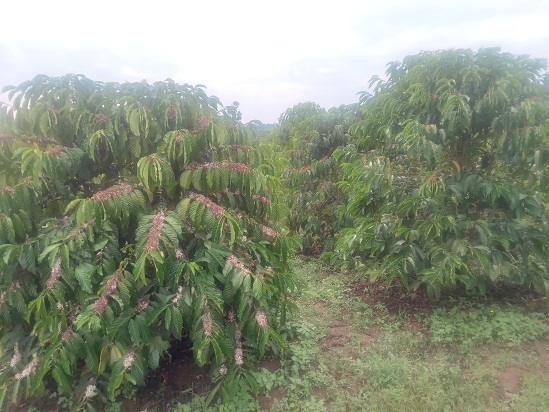Robusta coffee accounts for over 80% of Uganda’s coffee production. Coffee Berry Moth is the latest threat to Robusta production
A team of researchers have found out that a caterpillar, Coffee Berry Moth, is another threat to Robusta coffee production in Uganda.
Robusta coffee is believed to be indigenous to Uganda and accounts for about 80% of the country’s production.
Scientists led by Dr. Godfrey H. Kagezi of National Coffee Research Institute (NaCORI) in their research work titled Coffee Berry Moth, Prophantis smaragdina (Butler) (Lepidoptera: Pyralidae): Another threat to Robusta coffee, Coffea canephora production in Uganda, say the new threat should be taken seriously because it reduces production and impacts on the qualitty of coffee.
The research was recently published in the Uganda Journal of Agricultural Sciences. The National Coffee Research Institute (NaCORI) and Uganda Coffee Development Authority (UCDA) conducted a rapid assessment mini study at Kaweri and the surrounding villages to establish the damage levels and farmers’ knowledge of Coffee Berry Moth.
Coffee Berry Moth
The Coffee Berry Moth (CBM) is a widely distributed coffee pest and has been reported in sub-Saharan Africa, Madagascar, the Indian Ocean islands and some parts of Asia. This pest species has been existing in Uganda since the 1940’s but with low economic importance as in other countries in the East African region. However, it has of recent gained importance and is currently one of the major pests infesting coffee not only in Uganda but also in the region.
Damage caused by the pest has been reported to negatively affect coffee yield and therefore, has the capacity to cause high losses in coffee.
The research says that the management of Kaweri Coffee Plantation Limited, Uganda, reported that the pest had caused an estimated coffee loss of more than 40% in the year 2020.
Furthermore, research studies showed that the pest could be present on coffee throughout the year.
Managing the pest is reported to be difficult because, once the berry clusters are webbed, insecticide sprays will not penetrate them. However, cultural methods have been used to manage this insect pest. In case of heavy infestation, it is recommended to strip off the infested berry clusters by hand. These materials should then be placed in holes and covered with a fine mesh that prevents the adults from escaping but allowing adult parasitoids to go back to the coffee fields.
Study
The rapid assessment was conducted in Kaweri Coffee Plantation Limited and the surrounding villages to respond to concerns of an outbreak of Coffee Berry Moth (CBM) on coffee by the management of the plantation. The plantation is located in Naluwondwa parish, Madudu sub-county, Buwekula County, Mubende District.
A structured questionnaire eliciting farmers’ knowledge on the pest status, ecology and management of the Coffee Berry Moth (CBM) on Robusta coffee was administered to 10 randomly selected farmers surrounding Kaweri Coffee Plantation Limited in the sub-counties of Madudu and Kitenga.
In addition, a biological study was conducted in the coffee gardens of five of the farmers that were interviewed.
The assessment was also done in the four sections of Kaweri – Kitagweta, Kyamutuma, Luwunga and Nonve. In each sampled garden, 10 coffee trees were randomly selected along a transect. The canopy of each of the selected coffee trees was divided into the upper and lower portions. One primary branch was selected randomly in each of the portions and the number of all the berry clusters and those damaged by CBM was established to compute the percentage damage. One berry cluster was then randomly selected and the number of all berries and those damaged by CBM was established and used to compute the percentage damage. CBM-infested coffee berries are brown/black, dry, hollow and usually webbed together.
Results
Results showed that half of the farmers interviewed had knowledge of CBM and, of these, 50% of them mentioned that they first observed CBM in their coffee gardens in the last three years. In addition, 42.8% of these farmers were of the view that the pest had no effect on coffee yields whereas, 57.2% of them could identify the pest by the silk webs it forms around the infested coffee berries.
The study further revealed that farmers were aware of seasonal changes in damage caused by CBM with 57.2% of those who knew the pest mentioning that it causes more damage to coffee in the dry season. On the other hand, 71.4% of the farmers who knew CBM, did not know the effect of shade on its infestation while, none of them knew alternative host plant species for the pest. Also, 71.4% of the farmers who knew CBM, did not have knowledge of its management, though, 14.2% of them mentioned that they were physically removing infested berries and burning or burying them.
The report shows that the percentage of coffee berry clusters infested by CBM varied significantly across both the sections at Kaweri and farmers’ coffee gardens. However, the percentage of CBM-infested berries varied significantly for only Kaweri but not in the farmers’ gardens. On average, 31.2 and 12.6% of the coffee berry cluster and berries respectively, were infested by CBM and for both, the highest infestation was recorded in Kitagweta section (48.9%).
Furthermore, results showed that the percentage of both coffee berry clusters and berries damaged by CBM was significantly higher at Kaweri Coffee Plantation compared to the farmers’ gardens.
Scientists observed that the highest percentage of badly managed coffee crops were observed in the Kitagweta section – with all the coffee plants either not managed at all or poorly managed.
The scientists say this could have partly contributed to the higher level of CBM in this section as compared to other sections.
In addition, the regression analysis results showed that the percentage of coffee berries infested by CBM decreased with plant management (pruning and de-suckering). However, this relationship was significant for pruning but not de-suckering.
“This implies that pruning might be partly influencing damage caused by CBM,”the research reads in part.
They also observed that the success of any program for managing pests depends largely on farmers’ motivations, skills and knowledge. This, they say, is because farmers have their own practices, knowledge, and ideas on how a given problem can be resolved in the most feasible way
” It is therefore important to understand the basic knowledge, perception and skills of farmers when developing and implementing sustainable pest and disease management strategies that can be adopted by many farmers. Our results showed that half of the farmers interviewed had knowledge of CBM and this funding agrees with Liebig who also reported that more than half of the Arabica coffee farmers of Mt Elgon region, eastern Uganda knew CBM,” the report says.
It adds: “Farmers’ inability to correctly identify pests could result in indiscriminate application of pesticides resulting in the destruction of beneficial organisms in the ecosystem. Furthermore, results also showed that more than half of those farmers who knew CBM, mentioned that they first observed it on their coffee in the last three years. This implies that this insect pest has just gained economic importance on coffee in the last few years, though it has been in existence on coffee in the country for some time.”
They also agreed that farmers’ ability to properly identify insect pests is one of the ways that lead to their successful control and therefore increase production and productivity.
In conclusion, the scientists observed that the Coffee Berry Moth is gaining economic importance as a pest infesting Robusta coffee as evidenced at Kaweri Coffee Plantation Limited.
Since it directly attacks coffee berries (beans) and this is the final coffee product for consumption, scientists say that the damage this moth causes does not affect only yields, but also quality.
“It was also observed that farmers’ knowledge on the bio-ecology and management of this pest is limited. This coupled with scanty literature on CBM in Uganda calls for urgent research to develop integrated management strategies for this insect pest,” reads the report.
Other Threats
Besides climate change that has come with unbearable dry spells, Robusta coffee farmers face a host of challenges including but not limited to tailed caterpillars, Black Coffee Twig Borer (BCTB), leaf skeletonizers, red blister disease, brown eye spot and Coffee Wilt Disease (CWD) which remains a serious threat to many coffee fields in Robusta regions.





